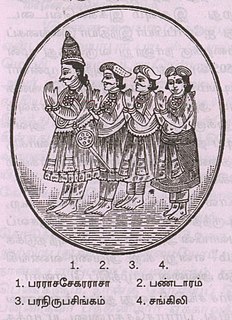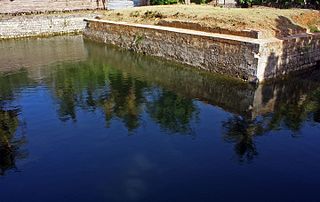
The Aryacakravarti dynasty were kings of the Jaffna Kingdom in Sri Lanka. The earliest Sri Lankan sources, between 1277 and 1283, mention a military leader of this name as a minister in the services of the Pandyan Empire; he raided the western Sri Lankan coast and took the politically significant relic of the Buddha’s tooth from the Sinhalese capital city of Yapahuwa. Political and military leaders of the same family name left a number of inscriptions in the modern-day Tamil Nadu state, with dates ranging from 1272 to 1305, during the late Pandyan Empire. According to contemporary native literature, such as Cekaracecekaramalai, the family also claimed lineage from the Tamil Brahmins of the prominent Hindu pilgrimage temple of Rameswaram in the modern Ramanathapuram District of India. They ruled the Jaffna kingdom from the 13th until the 17th century, when the last of the dynasty, Cankili II, was ousted by the Portuguese.
Nalavar is a Tamil caste found in Sri Lanka. They were traditionally occupied in palm tree climbing and toddy tapping.
Koviar is a Tamil caste found in Sri Lanka. They are traditional agriculturalists and temple workers.

Cankili I, also known as Segarasasekaram, is the most remembered Jaffna kingdom king in the Sri Lankan Tamil history. He was very active in resisting Portuguese colonial inroads into Sri Lanka. He also inherited his throne via palace intrigues in which number of heir apparent’s died under mysterious circumstances. At the end, he was removed from power by a local uprising that led to his son Puviraja Pandaram taking nominal power from him.

Nallur is a suburb in Jaffna, Sri Lanka. It is located 3 km south from the city centre of Jaffna. Nallur is famous for the Nallur Kandaswamy temple a popular place of worship and respectively the largest Saiva temple on the peninsula. It is also famous for being the historical capital of the old Jaffna Kingdom and birthplace of renowned philosopher and theologian Arumuka Navalar.
Martanda Cinkaiariyan ascended the throne of Jaffna Kingdom under the throne name Pararasasekaram III. He is one of the early Aryacakravarti kings about whom historical and epigraphical evidence is available. He was noted by Ibn Battuta in his well-known travelogue as well as he has left behind a few inscriptions. He oversaw the international trade of the Jaffna kingdom with Yemen via the kingdom's powerful trading ships. Martanda Cinkaiariyan accompanied Battuta to the peak of Sivanoli Padam Malai along with Yogis and other Hindus and companions of the king who visited the sacred Shiva site annually.

Cankili II was the self-proclaimed last king of the Jaffna kingdom and was a usurper who came to throne with a palace massacre of the royal princess and the regent Arasakesari in 1617. His regency was rejected by the Portuguese colonials in Colombo, Sri Lanka. His reign was secured with military forces from the Thanjavur Nayaks and Karaiyar captains. He was defeated by the Portuguese in 1619 and was taken to Goa and hanged. With his death the Aryacakravarti line of Kings who had ruled the kingdom for over 300 years came to an end.
Vanniar or Vanniyar is a title of a chief in medieval Sri Lanka who ruled in the Chiefdom of Vanni regions as tribute payers to the Jaffna vassal state. There are a number of origin theories for the feudal chiefs, coming from an indigenous formation. The most famous of the Vanni chieftains was Pandara Vannian, known for his resistance against the British colonial power.

The Vanni Nadu were feudal land divisions ruled by chiefs south of the Jaffna peninsula in northern Sri Lanka. These chieftaincies arose in the 12th century, with the rise of the medieval Tamil kingdom's golden age and the collapse of the Rajarata kingdom. The chieftaincies developed in sparsely settled areas, and were ruled by Vanniars. An extension of the Jaffna kingdom's territory, the chiefs of the Vanni Nadu were, for most of their existence, tribute-paying subordinates to Jaffna. At 1621, the Jaffna Kingdom was conquered by the Portuguese and the Vanni chiefs became tributaries of the Portuguese Ceylon. The Portuguese colony in Sri Lanka was later taken over by the Dutch. During the Dutch rule it came to Vannian resistances against the colonial rule, one of these was the rebellion of Pandara Vanniyan. Allied with the Kingdom of Kandy, Pandara Vanniyan fought with guerrilla tactics against the Dutch and British. At 1803, he was defeated by Lt. von Driberg and Vanni fell into hands of the British. Vanni had been reincorporated with Jaffna Peninsula to form the Malabar Coylot Vanni country which later became the Northern Province of Sri Lanka.
Kulasekara Cinkaiariyan is considered to be the first of the Aryacakravarti dynasty kings to establish his rule over the Jaffna Kingdom in modern Sri Lanka.
The researcher into genealogy in Sri Lanka, faces a significant problem due to the lack of reliable source material. Unlike in the west, where there has been a long tradition of documenting genealogical data from very early times, in Sri Lanka it is only after the advent of the Portuguese that such information was recorded systematically in the Parish records. These records were destroyed by the Portuguese to prevent it from falling into the hands of the advancing Dutch Army.
Vickrama Cinkaiariyan was the fourth of the Aryacakravarti kings of Jaffna Kingdom. Author of the book “Ancient Jaffna” C. Rasanayagam calculated that he has been ruled Jaffna from 1279 to 1302. Yalpana Vaipava Malai says during his rule the county was in disorder. Riot occurred between Sinhalese and Tamils. Vickrama Cinkaiariyan ordered death sentences 17 Sinhalese and imprisoned many Sinhalese after the murder of 2 Tamils.
Gunabhooshana Cinkaiariyan was a king of the Aryacakravarti dynasty and he ruled over the Jaffna Kingdom in modern Sri Lanka. Yalpana Vaipava Malai indicates that he was the son of Martanda Cinkaiariyan. He was a popular king than his father due to his contribution on education, employment, etc. During his rule, the country was firm and steady.
Virodaya Cinkaiariyan was the Aryacakravarti king of the Jaffna Kingdom in modern-day northern Sri Lanka. Tamil historical writer C. Rasanayagam calculated Virodaya Cinkaiariyan’s reign was from 1371 to 1394 while Swamy Gnanapirakasar calculated from 1344 to 1380. During his reign, Vanniar incited Sinhalese for rebellion, which resulted suppression of rebellion, Virodaya’ innovation against Vanniar and they suffered.
Gunaveera Cinkaiariyan was an Aryacakravarti kings of Jaffna Kingdom. Local source says that he has been ruled Jaffna from 1414 or 1417. After his reign, his son Kanakasooriya Cinkaiariyan ruled the Jaffna kingdom
Kasi Nayinar Pararacacekaran was of one of the Aryacakravarti rulers of Jaffna kingdom who followed in the chaotic period after the death of Cankili I(1519–1561), and he removed Puviraja Pandaram. He was not from royal family, which made despite against him, and his enemies approached Portuguese, who ruled from Mannar. Portuguese utilized this opportunity and fought with Kasi Nayinar, and he was imprisoned. Portuguese appointed a king, and later he became victim to the supporters of Kasi Nayinar. After he rescued, again he ruled Jaffna and soon he poisoned by his servant with the support of Portuguese.

Yamuna Eri is an ancient pond situated in Nallur, Jaffna, Sri Lanka. In 1948, it was listed as one of the protected archaeological monuments in the Jaffna District by the Sri Lankan government.
The Kotte conquest of the Jaffna kingdom was an expedition against the Jaffna kingdom by the Kotte kingdom. The Kotte's campaign had several phases against Jaffna dated between A.D. 1449–50 and 1453-4. The first campaign, led by Prince Sapumal, adopted son of Parakramabahu VI in 1450. In the second campaign, Prince Sapuma defeated Kanakasooriya Cinkaiariyan and ruled the region nearly 17 years as a representative of Kotte.
Kadaiyar is a Tamil caste found in the Indian state of Tamil Nadu and Sri Lanka. They are traditionally involved in lime burning and pearl hunting. They are considered a subcaste of the agriculturalist Devendrakula Velalar and are also known as Kadaisiyar.







